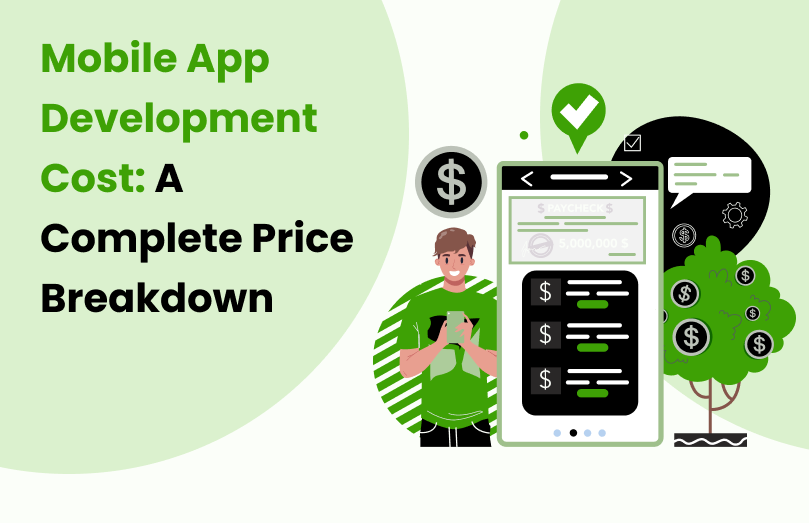The creation of mobile apps is becoming an essential component of current corporate operations. With more than 3.8 billion smartphone users globally, having a mobile app may help businesses stand out from the competition and expand their customer base. However, depending on elements like complexity, features, and platform, the price of developing a mobile app might vary significantly.
Recent studies show that the average mobile app development cost in USA may range from $75,000 to $500,000. Even though this may seem significant, remember that a well-designed and useful app may offer a high return on investment through improved consumer engagement and income.
Mobile apps are becoming more needed than a luxury as mobile technology develops and changes how we live and work. Businesses may benefit from a high-quality, user-friendly app that can draw and engage users, generate income, and enhance overall digital presence by investing in expert Flutter app development services. Despite the upfront expense, spending money on mobile app development is a wise business move with long-term advantages. So if you’re a business owner wanting to construct a new app or just wondering how much it would cost to design a mobile app, stay reading to find out more.
Cost Analysis for Developing Mobile Applications
The truth is that most clients who visit for a consultation about an app concept are unaware of how to develop an application for mobile devices or how much it will cost. They will probably inquire about pricing and have a general idea of the app’s capabilities. Sadly, a general description of the app’s features is insufficient for a reasonable price projection, and to be completely honest, it’s nearly hard to provide a concrete response to the issue of the amount it costs to design an application without an in-depth comprehension of its functioning and extensive research.
- Prices, skills, and experience of app developers
- Platform costs: positives and negatives?
- Types of technology used to produce mobile applications
- Mobile App Functionality
- Hardware Integration
- Additional Financial Factors for Mobile Applications
Overall, you may determine the price of producing an application for mobile devices by looking at how much the developers charge. It means that the application price would be $20,000 for an undertaking that requires 400 programmers charging an hourly rate of $50.
Total number of hours*cost per hour = cost
However, it is not straightforward to calculate the time a company will require to create a mobile application. It differs based on the level of complexity and kind of functionality in the application you are developing. The price of creating a mobile app may be determined as follows:
Mobile App Development Costs Breakdown
1. Prices, Skills, and Experience of App Developers
Both experience changes and pricing influence the cost of employing developers. If your organization wants to build the next Snapchat or Uber, it may need to find the right mix of specialities while building a development team:
- Entry-Level Developers: Beginner developers: If you’re ready to offer minimal on-the-job learning, entry-level developers may assist with debugging tasks, app upkeep, code records, and easy feature requests for about $40 per hour.
- Moderate Developers: These professionals charge an hourly rate of about $80 and possess the fundamental expertise required to execute most app design duties and new feature requests.
- Experienced Developers: These professionals may oversee the development of your application and projects or incorporate cutting-edge features into your application for a standard price of $140 per hour.
2. Platform Costs: Positives and Negatives
There is no doubt that your business will profit from the two marketplaces. However, you shouldn’t feel uncomfortable beginning with the platform that most effectively meets your demands and increasing your clientele once you first get your investment return. Here is a quick analysis of the benefits and drawbacks of both platforms Android and iOS to assist you in making your decision.
- Development Time: Android apps get evaluated on a wider variety of devices with different sizes of screens, resolutions, and operating system versions. Thus it takes a long time to build, which might raise the total cost of development.
- Design: iOS apps need developers to adhere to precise design requirements, which helps streamline and shorten development. On the other side, Android applications provide more design freedom, which may necessitate more design iterations and raise the cost of development.
- Development Tools: Swift and Objective-C are employed for creating Android apps, whereas Java or Kotlin are used to create Android apps. If developers have greater familiarity with one language than the other, it can affect the development cost.
- Market Share: Due to Android’s more significant worldwide market share, producing an Android app may require more effort to optimize various devices, raising the total development cost.
- Developer Zone: The team’s location also influences the cost of developing an app. Generally speaking, Western coders charge more than Eastern coders. As a result, the price of developing an app might differ depending on the development team’s location.
3. Type of Technologies Used to develop Mobile Applications
The technology you select to engage in the construction of your mobile app development venture will undoubtedly significantly affect the final price of the application.
Web Application
Technically speaking, a mobile-friendly website rather than a mobile app that uses a responsive design to ensure a seamless user experience on a range of screens, from tablets to smartphones. For many small firms, this is undoubtedly the most affordable choice.
Native Application
Improved efficiency is the native apps’ main benefit. A native app is built using a language native to the operating system of a given platform or device. That entails utilizing Java or Kotlin for Android and Swift or Objective-C for iOS. The main drawback is that you must specifically design the application for each OS if you wish for it to function on both platforms. Increased development expenses are an expected result of this doubling of efforts.
Hybrid Software
The hybrid app finds a fair compromise between functionality and programmer efficiency by allowing you to construct a mobile application utilizing the three major essential web technologies—HTML, CSS, and JavaScript—with frameworks like Ionic and Cordova. It lowers development expenses.
Cross-Platform Application
The ability to write the application in a single language and convert it into native code for use on several platforms is made possible by cross-platform app development frameworks like Xamarin and PhoneGap. While a cross-platform programme cannot function as effectively as one designed natively, many projects find the benefit of a uniform codebase over numerous platforms worthwhile.
Modern JavaScript Frameworks
It’s additionally essential to note that an entirely novel category of cross-platform applications that utilize components-oriented JavaScript frameworks (like React Native) and deliver performance close to native apps. Although these applications are written in JavaScript, they offer native views. It’s worth employing React Native to create cross-platform applications.

4. Mobile App Functionality
According to the sort of app, the particular collection of fundamental functions may vary. However, some typical examples include:
- User registration and authentication
- In-app search functionality
- Social media integration
- Push notifications
- Analytics and reporting
- In-app messaging or chat
- User profile management
- GPS and location-based services
- Push notifications
- In-app purchase functionality
- Payment processing
- In-app messaging or chat
Adding these functionalities in several ways may impact mobile app development costs.
Initially, the level of complexity of the features might affect the length of time and development price. For instance, establishing user login and registration features can appear simple. However, security factors must be considered, which can make the development process more complex and take longer.
Secondly, including services from other parties may raise the price of development. For instance, integrating a social networking platform or a payment processing system necessitates more development effort, which might extend the time and expense of development.
Finally, the app’s user interface design might also affect how much it costs to produce. An intricate, highly interactive user interface necessitates more skill and development time, which might raise the price.
5. Hardware Integration
Hardware integration can considerably impact a mobile app’s development costs because it includes integrating the application with different hardware devices or components. GPS, sensors, cameras and Bluetooth are a few examples of hardware integration in mobile applications.
The effect of hardware integration on development costs relies on several variables, including the degree of difficulty of the integration, the compatibility of the hardware device, and the level of knowledge needed to execute the integration effectively.
The abilities required for integrating the hardware may affect the development cost. Understanding and implementing the requisite hardware integration could take more time and money if the development team is underqualified.
6. Additional Factors Affecting Mobile App Development Cost
In addition to functionality and hardware integrations, consider these points that follow to help you find mobile app development cost estimate:
- Integration With Different Systems: Applications programming interfaces, or APIs, enable your app to participate in the API economy. Whether you’re integrating with private or public third-party APIs, it will increase your development expenses.
- Required Infrastructure: Databases, cloud storage, and network security are all back-end factors directly affecting development expenses.
- Constant Upkeep: Technically speaking, mobile applications are never complete. Considerations for upkeep, such as security upgrades, routine fixes, and debugging tasks, are crucial.
Summing Up
Consider investing in mobile app development to improve your company’s digital visibility and expand your customer base. Although there may be some initial costs, the long-term benefits might compensate for them.
Investing in specialized mobile app development and design services that can produce high-quality, user-friendly apps is imperative to ensure your mobile app’s success. At MMF Infotech, we provide complete end-to-end solutions that satisfy your unique objectives and budget while delivering mobile app development and design services to businesses of all sizes. To find out more, call us right away.


